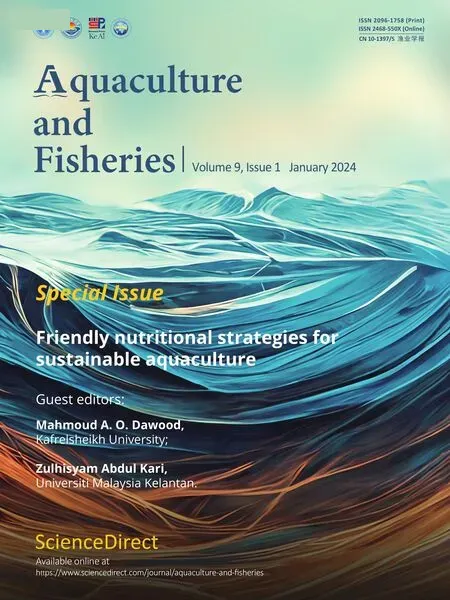Editorial special issue: Friendly nutritional strategies for sustainable aquaculture
Keywords Aquafeed industry Alternative remedy Functional supplements Feeding strategies Sustainability
The aquaculture sector provides the primary protein source for the global population while generating income and revenue (FAO,2020).Apart from that,aquaculturists are responsible for developing and maintaining sustainable production methods,including aquafeed production (Albrektsen et al.,2022).In recent years,increasing evidence has demonstrated the association between aquaculture species’ diet and their immunity status,thus,demanding further investigation.A high-quality feed should promote optimal and superior health,such as a robust immune system and well-being (Dawood,2021).A recent trend in aquaculture management is boosting immune response via nutritional strategies.Therefore,this issue explored the relationship between nutrition and immunity in aquatic animals by analyzing nutritional strategies using feed additives derived from sustainable sources.Furthermore,the relationship between nutrition,immune function,and the disease resistance of many famous cultured species was reviewed.Ultimately,this issue provides insights into current and future nutritional strategies to promote the immune system of a particular species for sustainable aquaculture.
The special issue titled “friendly nutritional strategies for sustainable aquaculture” is introduced to researchers and industry.We evaluated and accepted 12 articles from the outputs of different aquaculture nutrition laboratories worldwide.As an introduction,Magbanua and Ragaza (2022) reviewed the importance of plant-based proteins for growth and health response in Nile tilapia species,including soybean,copra,pea,corn,palm kernel,microalgae,and seaweed as Nile tilapia feed as potential fish meal alternatives.In addition,the recommended plant-based proteins are economical and nutritious,thus,sustainable as raw materials for aquafeed production.Nevertheless,plant-based protein usage has several challenges,such as low amino acids,anti-nutritional factors (ANFs),and human food demand.Subsequently,Kari et al.(2022) reviewed the roles of polysaccharides in tilapia farming and emphasized how polysaccharides potentially enhance growth performances,immune system,disease resistance,and protection against abiotic stressors,hence,improving fish production.Meanwhile,Wee et al.(2022) recommended prebiotic mixtures as feed additives to boost the growth,immunity,and disease resistance and reduce the stress level of aquatic animals.
The advantages of probiotics were featured in the study by Hossain et al.(2022).Host-associated probiotics (HAPs) incorporation at an early stage,notablyE.faecalisstrain FC11682,promotedT.tambroidesgrowth,hypertrophic muscle development,and gut histopathology.In addition,the potential of black soldier fly larvae meal as a fish meal replacement was demonstrated in a study by Muin and Taufek (2022) by enhancing tilapia growth parameters and health status.Meanwhile,Tuan Harith et al.(2022) discovered that the dietary supplementation of astaxanthin from green algae as an alternative natural carotenoid resulted in good pigmentation and improvedOreochromissp.skin color.In another study,El Basuini et al.(2022) revealed that dietary supplementation of ≥100 mg/kg nano curcumin boosted non-specific immune response,antioxidant,and gut microbiota in Nile tilapia.Rekha et al.(2022) explored the potential of carotenogenic marine yeast as a feed supplement for pigment enhancement in Koi carp,Cyprinus carpio,which also improved the growth performance and survival rate of the aquaculture species.Moreover,the protective effects of turmeric aqueous extract (TAE) in spotted seabass (Lateolabrax maculatus) were investigated by Wang et al.(2022).It was postulated that the TAE enhanced the antioxidant capacity in the fish via the Nrf2/Keap1 pathway against H2O2-induced oxidative stress.
The supplementation of live feed could benefit aquaculture species,such as European seabass,Dicentrarchus labrax.El-Dahhar et al.(2022)demonstrated that augmentedArtemia naupliiwith fish oil+vitamin E only or in combination with vitamin C as low-cost antioxidants in larval diet could support their growth,survival,and antioxidant efficacy during the critical weaning phase.In a different study,Emam et al.(2021)discovered thatMoringa oleifera(MOAE) supplementation at 200 mg/kg in Nile tilapia enhanced growth performance,hematological parameters,and liver and kidney functions.Meanwhile,MOAE >200 mg/kg should not be incorporated in fish feed to avoid adverse effects on fish health.Finally,Abdullah et al.(2022) indicated the positive influence ofSpirulina platensis(SP) on histological and histochemical parameters of fish liver and the protective effects against ethidium bromide (EtBr).
We believe the articles presented in this special issue will garner much attention from readers worldwide as the issues highlighted are in line with the Sustainable Development Goals (SDGs) adopted by the United Nations in 2015,with the aims of ending poverty,protecting the planet,and ensure peace and prosperity globally by 2030.Furthermore,the industry and researcher could use the insights provided by the authors to establish a better nutritional strategy for sustainable aquaculture.As a guest editor of this special issue,we would like to convey our most profound appreciation to all authors for their contribution and willingness to share their invaluable discoveries with Aquaculture and Fisheries and the readers.We would also like to thank the reviewers for their constructive comments in producing articles of the highest quality.
 Aquaculture and Fisheries2024年1期
Aquaculture and Fisheries2024年1期
- Aquaculture and Fisheries的其它文章
- Selected dietary plant-based proteins for growth and health response of Nile tilapia Oreochromis niloticus
- The roles of polysaccharides in tilapia farming: A review
- The effects of mixed prebiotics in aquaculture: A review
- Growth performance,fatty acid profile,gut,and muscle histo-morphology of Malaysian mahseer,Tor tambroides post larvae fed short-term host associated probiotics
- Evaluation of growth performance,feed efficiency and nutrient digestibility of red hybrid tilapia fed dietary inclusion of black soldier fly larvae(Hermetia illucens)
- Effects of dietary astaxanthin enrichment on enhancing the colour and growth of red tilapia,Oreochromis sp.
